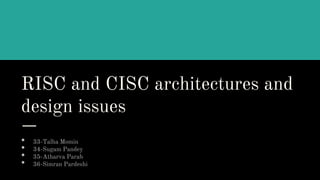
Dsdco IE: RISC and CISC architectures and design issues
- 1. RISC and CISC architectures and design issues • 33-Talha Momin • 34-Sugam Pandey • 35-Atharva Parab • 36-Simran Pardeshi
- 2. RISC Reduced Instruction Set Architecture The Sun Microsystems UltraSPARC processor is a type of RISC microprocessor.
- 3. What is RISC? • Reduced Instruction Set Computer is a type of microprocessor architecture that utilizes a small, highly-optimized set of instructions rather than the highly-specialized set of instructions typically found in other architectures. • RISC is an alternative to the Complex Instruction Set Computing (CISC) architecture and is often considered the most efficient CPU architecture technology available today. • With RISC, a central processing unit (CPU) implements the processor design principle of simplified instructions that can do less but can execute more rapidly. The result is improved performance.
- 4. Characteristics of RISC • Simpler instruction, hence simple instruction decoding. • Instruction comes undersize of one word. • Instruction takes a single clock cycle to get executed. • More general-purpose registers. • Simple Addressing Modes. • Less Data types. • Pipeline can be achieved.
- 5. CISC Complex Instruction Set Computer
- 6. What is CISC? ● The CISC architecture tries to reduce the number of Instructions that a program has, thus optimizing the Instructions per Program part of the above equation. This is done by combining many simple instructions into a single complex one. ● The CISC architecture can be better explained with the analogy of a dog: ● In the dog analogy, “Fetch” can be thought of as a CISC instruction. When a dog “Fetches” a ball, it is actually doing a series of instructions that include: “Follow the ball” then “Pick it up” followed by “Go back to human” and finally, “Give human the ball”. ● It is obvious that giving a dog a single “fetch” instruction is easier and faster than giving it four separate instructions. And this is why initial CPU manufacturers like Intel designed CISC processors.
- 7. Characteristics of CISC Since the instructions are complex the decoding is complex as well. Instructions are larger than one-word size. Instruction may take more than a single clock cycle to get executed. Less number of general-purpose registers as the operation gets performed in memory itself. Complex Addressing Modes. More Data types.
- 8. RISC o RISC tries to reduce the time taken for each instruction to execute. o In RISC however, since all instructions take one cycle, pipelining instructions is easier. o Transistors are used for more registers. o Can perform only Register to Register Arithmetic operations. o Requires more number of registers CISC o While CISC tries to complete an action in as lines of assembly code as possible o CISC instructions take a more number of cycles to execute, parallelism and pipelining of instructions is much harder. o Can perform REG to REG or REG to MEM or MEM to MEM o Requires less number of registers
- 9. Example
- 10. X Y 1 2 3 4 1 2 3 4 RA R B Memory Register Set Execution Unit In CISC: • MULT 2:2, 3:3 x , y • X=x*y In RISC: • LOAD A, 2:2 • LOAD B, 3:3 • PROD A,B • STORE 2:2,A
- 11. Applications in real life: • Intel and AMD’s processor’s till this day use CISC architecture. • A very recent example of RISC architecture being used are Apple’s self designed ARM based M1 chips which are their most powerful and performance efficient chips so far. • By the beginning of the 21st century, the majority of low-end and mobile systems relied on RISC architectures. Examples include: • The ARM architecture dominates the market for low power and low cost embedded systems. It is used in a number of systems such as most Android-based systems, the Apple iPhone and iPad, Microsoft Windows Phone, Nintendo Game Boy Advance, DS, 3DS and Switch, Raspberry Pi, etc. • IBM's PowerPC was used in the GameCube, Wii, PlayStation 3, Xbox 360 and Wii U gaming consoles. • The world’s fastest super computer Fugaku is also based on ARM architecture which itself is a family of RISC.
- 12. Conclusion ● As you can might have learned both the architectures have actually come a long way since their inception. ● In today’s modern world CPU technology has come so far that CISC and RISC barely have any difference in performance. ● Execution speed now depends heavily upon caching. CPU speeds have indeed risen—to the point that clock speed is limited almost entirely by power consumption which limits RISC and CISC designs to roughly the same clock speeds. ● Thus that much explains how RISC and CISC are now roughly at technical parity.